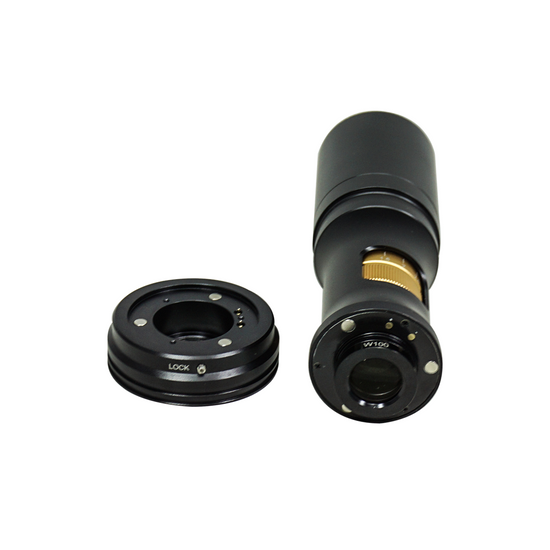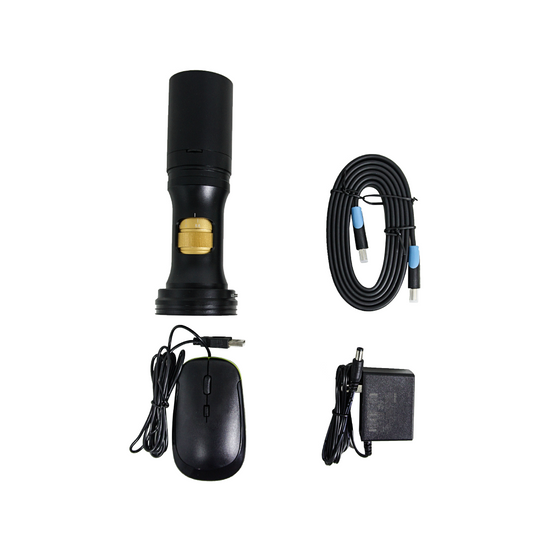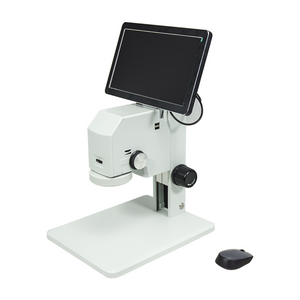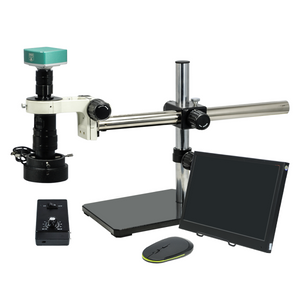Quick Overview
Infinite. Total Magnification: 0.35-2.8X. 1X Achromatic Objective. Standard Coupler: 1X. Zoom Ratio: 1:8. Illumination Type: LED Reflection Light. Top Illumination: Ring Light. CMOS. 2.0 Megapixels. HDMI / USB 2.0. Input Voltage: AC 100-240V 50/60Hz.
DM29011101 Digital Microscope Body
Optical System Specifications
| Optical System | Infinite |
| System Optical Magnification | 0.35-2.8X |
| Total Magnification | 0.35-2.8X |
| Standard Objective | 1X Achromatic Objective |
| Standard Coupler | 1X |
| System Working Distance | 80mm |
Video Monocular Zoom Body
| Body Optical System | Infinite |
| Body Magnification | 0.7-5.6X |
| Zoom Range | 0.7-5.6X |
| Zoom Ratio | 1:8 |
| Zoom Operating Mode | With the Zoom Ring |
| Erect/Inverted Image | Erect image |
| Illumination Type | LED Reflection Light |
| Top Illumination | Ring Light |
| Top Illumination Type | LED |
| LED Quantity | 48 |
| Image Sensor | CMOS |
| Image Sensor Size | 1/2.8 in. |
| Camera Maximum Pixels | 2.0 Megapixels |
| Camera Resolution | 1920x1080 |
| Camera Signal Output Port | HDMI / USB 2.0 |
| Transmission Frame Rate | 60fps@1920x1080 |
| White Balance | Manual/Auto |
| Gain Control | Adjustable |
| Exposure Control | Manual/Auto |
| Input Voltage | AC 100-240V 50/60Hz |
| Output Voltage | DC 12V |
| Power Cord Connector Type | USA 2 Pins |
| Power Cable Length | 1.5m |
| Parts Certification | Power Supply with CE Certification |
| Material | Plastic |
| Color | Black |
| Net Weight | 0.50kg (1.10lbs) |
Monocular Video Auxiliary Lens
| 1X Auxiliary Objective | |
| Objective Optical System | Infinite |
| Objective Optical Magnification | 1X |
| Objective Type | Achromatic Objective |
| Objective Working Distance | 80mm |
| Objective Screw Thread | M26x1/36 in. |
| Objective Outer Diameter | Dia. 30mm |
| Barlow Lens | Yes |
| Surface Treatment | Electroplating Black |
| Material | Metal |
| Color | Black |
| Net Weight | 0.016kg (0.035lbs) |
| Applied Field | For DM2901 Series Digital Microscope Body |
Technical Info
Instructions
InfiniteClose Λ
| Microscopes and components have two types of optical path design structures. One type is finite optical structural design, in which light passing through the objective lens is directed at the intermediate image plane (located in the front focal plane of the eyepiece) and converges at that point. The finite structure is an integrated design, with a compact structure, and it is a kind of economical microscope. Another type is infinite optical structural design, in which the light between the tube lens after passing the objective lens becomes "parallel light". Within this distance, various kinds of optical components necessary such as beam splitters or optical filters call be added, and at the same time, this kind of design has better imaging results. As the design is modular, it is also called modular microscope. The modular structure facilitates the addition of different imaging and lighting accessories in the middle of the system as required. The main components of infinite and finite, especially objective lens, are usually not interchangeable for use, and even if they can be imaged, the image quality will also have some defects. The separative two-objective lens structure of the dual-light path of stereo microscope (SZ/FS microscope) is also known as Greenough. Parallel optical microscope uses a parallel structure (PZ microscope), which is different from the separative two-object lens structure, and because its objective lens is one and the same, it is therefore also known as the CMO common main objective. |
System Optical MagnificationClose Λ
| The magnification of the objective lens refers to the lateral magnification, it is the ratio of the image to the real size after the original image is magnified by the instrument. This multiple refers to the length or width of the magnified object. System optical magnification is the product of the eyepiece and the objective lens (objective lens zoom set) of the optical imaging part within the system. Optical magnification = eyepiece multiple X objective lens/objective lens set The maximum optical magnification of the microscope depends on the wavelength of the light to which the object is illuminated. The size of the object that can be observed must be greater than the wavelength of the light. Otherwise, the light cannot be reflected or transmitted, or recognized by the human eye. The shortest wavelength of ultraviolet light is 0.2 microns, so the resolution of the optical microscope in the visible range does not exceed 0.2 microns, or 200 nanometers. This size is converted to the magnification of the microscope, and it is the optical magnification of 2000X. Usually, the compound microscope can achieve 100X objective lens, the eyepiece is 20X, and the magnification can reach 2000X. If it is bigger, it will be called "invalid magnification", that is, the image is large, but the resolution is no longer increased, and no more details and information can be seen. |
Total MagnificationClose Λ
| Total magnification is the magnification of the observed object finally obtained by the instrument. This magnification is often the product of the optical magnification and the electronic magnification. When it is only optically magnified, the total magnification will be the optical magnification. Total magnification = optical magnification X electronic magnification Total magnification = (objective X photo eyepiece) X (display size / camera sensor target ) |
System Working DistanceClose Λ
| Working distance, also referred to as WD, is usually the vertical distance from the foremost surface end of the objective lens of the microscope to the surface of the observed object. When the working distance or WD is large, the space between the objective lens and the object to be observed is also large, which can facilitate operation and the use of corresponding lighting conditions. In general, system working distance is the working distance of the objective lens. When some other equipment, such as a light source etc., is used below the objective lens, the working distance (i.e., space) will become smaller. Working distance or WD is related to the design of the working distance of the objective lens. Generally speaking, the bigger the magnification of the objective lens, the smaller the working distance. Conversely, the smaller the magnification of the objective lens, the greater the working distance. When it is necessary to change the working distance requirement, it can be realized by changing the magnification of the objective lens. |
Video Monocular Zoom BodyClose Λ
| Video monocular zoom body is a zoom body that has only one set of optical paths, and it is also the body of the video continuous zoom. The upper end of the microscope body can be connected to the standard C-interface photo eyepiece, and then connected to the microscope camera; the lower end is the objective lens, and the objective lens of parallel structure is generally separated from the body, whereas the microscope body of finite structure is combined with the objective lens. Some bodies of microscope have also a light source coaxial illumination device. |
Zoom RangeClose Λ
| Zoom in zoom microscope means to obtain different magnifications by changing the focal length of the objective lens within a certain range through adjustment of some lens or lens set while not changing the position of the object plane (that is, the plane of the point of the observed object perpendicular to the optical axis) and the image plane (that is, the plane of the image imaging focus and perpendicular to the optical axis) of the microscope. Zoom range refers to the range in which the magnification is from low to high. In the zoom range of the microscope, there is no need to adjust the microscope knob for focusing, and ensure that the image is always clear during the entire zoom process. The larger the zoom range, the stronger the adaptability of the range for microscope observation, but the image effects at both ends of the low and high magnification should be taken into consideration, the larger the zoom range, the more difficult to design and manufacture, and the higher the cost will be. |
Zoom RatioClose Λ
| Zoom ratio is the ratio of the maximum magnification / the minimum magnification. Expressed as 1: (ratio of maximum magnification / minimum magnification). If the maximum magnification is 4.5X, the minimum magnification is 0.7X, then the zoom ratio = 4.5 / 0.7 = 6.4, the zoom ratio will be 1:6.4. Zoom ratio is obtained by the intermediate magnification group of the microscope. When the magnification is increased or decreased by using other objective lenses, the zoom ratio does not change accordingly. |
Erect/Inverted ImageClose Λ
| After imaging through a set of objective lenses, the object observed and the image seen by the human eye is inverted. When the observed object is manipulated, move the specimen or object, the image will move in the opposite direction in the field of view. Most of the biological microscopes are reversed-phase designs. When needing to operate works with accurate direction, it is necessary to design it into a forward microscope. Generally stereo microscopes and metallurgical microscopes are all of erect image design. When observing through the camera and display, the erect and inverted image can be changed by the orientation of the camera. |
CMOSClose Λ
| CMOS, or complementary metal oxide semiconductor. Both CMOS and CCD sensors have their own respective advantages and disadvantages. As a kind of photoelectric conversion sensor, among the current cameras, CMOS is relatively more widely used. |
Image Sensor SizeClose Λ
| The size of the CCD and CMOS image sensors is the size of the photosensitive device. The larger the area of the photosensitive device, the larger the CCD/CMOS area; the more photons are captured, the better the photographic performance; the higher the signal-to-noise ratio, the larger the photosensitive area, and the better the imaging effect. The size of the image sensor needs to match the size of the microscope's photographic eyepiece; otherwise, black borders or dark corners will appear within the field of view of observation. |
Camera Maximum PixelsClose Λ
| The pixel is determined by the number of photosensitive elements on the photoelectric sensor of the camera, and one photosensitive element corresponds to one pixel. Therefore, the more photosensitive elements, the larger the number of pixels; the better the imaging quality of the camera, and the higher the corresponding cost. The pixel unit is one, for example, 1.3 million pixels means 1.3 million pixels points, expressed as 1.3MP (Megapixels). |
Camera ResolutionClose Λ
| Resolution of the camera refers to the number of pixels accommodated within unit area of the image sensor of the camera. Image resolution is not represented by area, but by the number of pixels accommodated within the unit length of the rectangular side. The unit of length is generally represented by inch. |
Camera Signal Output PortClose Λ
| Digital signals output: USB 2.0, USB3.0; 15 Pin VGA; Firewire Port; HDMI; VGA; Camera Link etc. Analog signal output: BNC; RCA; Y-C etc. In addition, some cameras store and output images in the form of a memory card. Usually, industrial cameras often have several output modes on one camera for convenience purposes. |
Transmission Frame RateClose Λ
| Frame rate is the number of output of frames per second, FPS or Hertz for short. The number of frames per second (fps) or frame rate represents the number of times the graphics process is updated per second. Due to the physiological structure of the human eye, when the frame rate of the picture is higher than 16fps, it is considered to be coherent, and high frame rate can make the image frame more smooth and realistic. Some industrial inspection camera applications also require a much higher frame rate to meet certain specific needs. The higher the resolution of the camera, the lower the frame rate. Therefore, this should be taken into consideration during their selection. When needing to take static or still images, you often need a large resolution. When needing to operate under the microscope, or shooting dynamic images, frame rate should be first considered. In order to solve this problem, the general industrial camera design is to display the maximum frame rate and relatively smaller resolution when viewing; when shooting, the maximum resolution should be used; and some cameras need to set in advance different shooting resolutions when taking pictures, so as to achieve the best results. |
White BalanceClose Λ
| White balance is an indicator that describes the precision of white color generated in the image when the three primary colors of red, green and blue are mixed, which accurately reflects the color condition of the subject. There are manual white balance and automatic white balance. White balance of the camera is to "restore white objects to white color under any light source." The chromatic aberration phenomenon occurred under different light sources is compensated by enhancing the corresponding complementary color. Automatic white balance can generally be used, but under certain conditions if the hue is not ideal, options of other white balance may be selected. |
Objective Optical MagnificationClose Λ
| The finite objective is the lateral magnification of the primary image formed by the objective at a prescribed distance. Infinite objective is the lateral magnification of the real image produced by the combination of the objective and the tube lens. Infinite objective magnification = tube lens focal length (mm) / objective focal length (mm) Lateral magnification of the image, that is, the ratio of the size of the image to the size of the object. The larger the magnification of the objective, the higher the resolution, the smaller the corresponding field of view, and the shorter the working distance. |
Objective TypeClose Λ
| In the case of polychromatic light imaging, the aberration caused by the light of different wavelengths becomes chromatic aberration. Achromatic aberration is to correct the axial chromatic aberration to the two line spectra (C line, F line); apochromatic aberration is to correct the three line spectra (C line, D line, F line). The objective is designed according to the achromaticity and the flatness of the field of view. It can be divided into the following categories. Achromatic objective: achromatic objective has corrected the chromatic aberration, spherical aberration, and comatic aberration. The chromatic portion of the achromatic objective has corrected only red and green, so when using achromatic objective, yellow-green filters are often used to reduce aberrations. The aberration of the achromatic objective in the center of the field of view is basically corrected, and as its structure is simple, the cost is low, it is commonly used in a microscope. Semi-plan achromatic objective: in addition to meeting the requirements of achromatic objective, the curvature of field and astigmatism of the objective should also be properly corrected. Plan achromatic objective: in addition to meeting the requirements of achromatic objectives, the curvature of field and astigmatism of the objective should also be well corrected. The plan objective provides a very good correction of the image plane curvature in the field of view of the objective, making the entire field of view smooth and easy to observe, especially in measurement it has achieved a more accurate effect. Plan semi-apochromatic objective: in addition to meeting the requirements of plan achromatic objective, it is necessary to well correct the secondary spectrum of the objective (the axial chromatic aberration of the C line and the F line). Plan apochromatic objective: in addition to meeting the requirements of plan achromatic objective, it is necessary to very well correct the tertiary spectrum of the objective (the axial chromatic aberration of the C line, the D line and the F line) and spherochromatic aberration. The apochromatic aberration has corrected the chromatic aberration in the range of red, green and purple (basically the entire visible light), and there is basically no limitation on the imaging effect of the light source. Generally, the apochromatic aberration is used in a high magnification objective. |
Objective Working DistanceClose Λ
| The objective working distance is the vertical distance from the foremost surface end of the objective of the microscope to the object surface to be observed. Generally, the greater the magnification, the higher the resolution of the objective, and the smaller the working distance, the smaller the field of view. Conversely, the smaller the magnification, the lower the resolution of the objective, and the greater the working distance, and greater the field of view. High-magnification objectives (such as 80X and 100X objectives) have a very short working distance. Be very careful when focusing for observation. Generally, it is after the objective is in position, the axial limit protection is locked, then the objective is moved away from the direction of the observed object. The relatively greater working distance leaves a relatively large space between the objective and the object to be observed. It is suitable for under microscope operation, and it is also easier to use more illumination methods. The defect is that it may reduce the numerical aperture of the objective, thereby reducing the resolution. |
Objective Screw ThreadClose Λ
| For microscopes of different manufacturers and different models, the thread size of their objectives may also be different. In general, the objective threads are available in two standard sizes, allowing similar objectives between different manufacturers to be used interchangeably. One is the British system: RMS type objective thread: 4/5in X 1/36in, One is metric: M25 X 0.75mm thread. |
PackagingClose Λ
| After unpacking, carefully inspect the various random accessories and parts in the package to avoid omissions. In order to save space and ensure safety of components, some components will be placed outside the inner packaging box, so be careful of their inspection. For special packaging, it is generally after opening the box, all packaging boxes, protective foam, plastic bags should be kept for a period of time. If there is a problem during the return period, you can return or exchange the original. After the return period (usually 10-30 days, according to the manufacturer’s Instruction of Terms of Service), these packaging boxes may be disposed of if there is no problem. |
Optical Data
| Camera Image Sensor Specifications | |||
| No. | Camera Image Sensor Size | Camera image Sensor Diagonal | |
| (mm) | (inch) | ||
| 1 | 1/4 in. | 4mm | 0.157" |
| 2 | 1/3 in. | 6mm | 0.236" |
| 3 | 1/2.8 in. | 6.592mm | 0.260" |
| 4 | 1/2.86 in. | 6.592mm | 0.260" |
| 5 | 1/2.7 in. | 6.718mm | 0.264" |
| 6 | 1/2.5 in. | 7.182mm | 0.283" |
| 7 | 1/2.3 in. | 7.7mm | 0.303" |
| 8 | 1/2 in. | 8mm | 0.315" |
| 9 | 1/1.9 in. | 8.933mm | 0.352" |
| 10 | 1/1.8 in. | 8.933mm | 0.352" |
| Contains | ||||
| Parts Including |
|
| Packing | |
| Packaging Type | Metal Packaging |
| Packaging Material | Aluminum Case |
| Packaging Dimensions(1) | 39x26x14.5cm (15.354x10.236x5.709″) |
| Inner Packing Material | Plastic Bag |
| Ancillary Packaging Materials | Expanded Polystyrene |
| Gross Weight | 3.39kg (7.47lbs) |
| Minimum Packaging Quantity | 1pc |
| Transportation Carton | Metal Packaging |
| Transportation Carton Material | Aluminum Case |
| Transportation Carton Dimensions(1) | 39x26x14.5cm (15.354x10.236x5.709″) |
| Total Gross Weight of Transportation(kilogram) | 3.39 |
| Total Gross Weight of Transportation(pound) | 7.47 |
| Quantity of One Transportation Carton | 1pc |
  |




















